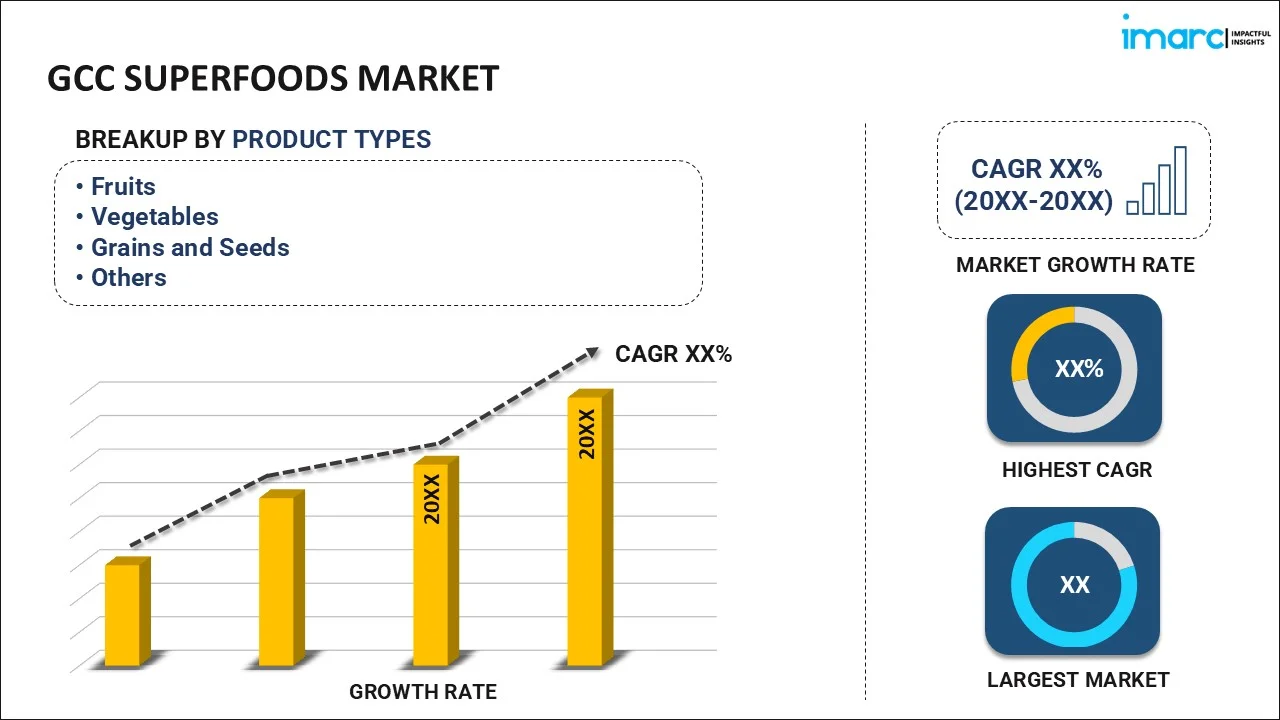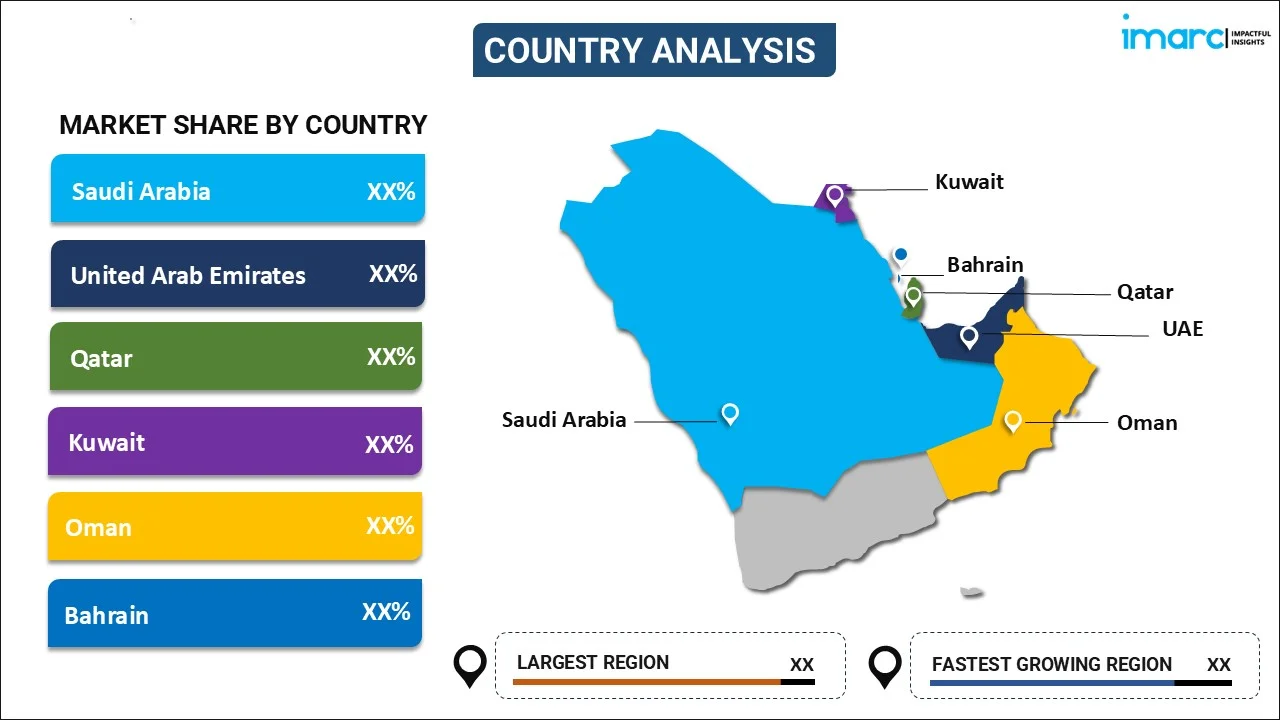
GCC Superfoods Market Report by Product Type (Fruits, Vegetables, Grains and Seeds, Herbs and Roots, Meat, and Others), Application (Bakery and Confectionery, Beverages, Supplements, Convenience/Ready-to-Eat Foods, and Others), Distribution Channel (Supermarkets and Hypermarkets, Convenience Stores, Specialty Stores, Independent Small Grocery Stores, Online Sales, and Others), and Country 2025-2033
Market Overview:
The GCC superfoods market size reached USD 3.4 Billion in 2024. Looking forward, IMARC Group expects the market to reach USD 5.5 Billion by 2033, exhibiting a growth rate (CAGR) of 5.3% during 2025-2033. The growing awareness and emphasis on healthier lifestyles and preventive healthcare, the exposure to global health trends, particularly through social media and the internet and rising demand for organic and sustainable food options represent some of the key factors driving the market.
|
Report Attribute
|
Key Statistics
|
|---|---|
|
Base Year
|
2024
|
|
Forecast Years
|
2025-2033
|
|
Historical Years
|
2019-2024
|
|
Market Size in 2024
|
USD 3.4 Billion |
|
Market Forecast in 2033
|
USD 5.5 Billion |
| Market Growth Rate 2025-2033 | 5.3% |
Superfoods, a term gaining popularity in the realm of nutrition and health, refers to a group of nutrient-dense foods that are believed to offer exceptional health benefits. The term superfood has emerged as a marketing concept, highlighting the nutritional density and potential health-promoting properties of these specific food items. Superfoods are increasingly sought after by health-conscious individuals and those looking to optimize their diet with nutrient-rich options. These foods are typically packed with vitamins, minerals, antioxidants, and other bioactive compounds that promote well-being and support overall health. Superfoods encompass a diverse range of fruits, vegetables, grains, seeds, and even certain seafood and dairy products. Incorporating them into the diet can be a convenient way to optimize nutritional intake. Superfoods can be easily incorporated into meals or snacks, whether consumed in their natural state, added to smoothies, used as toppings, or incorporated into recipes as flavorful ingredients. Superfoods are also valued for their potential to boost brain health and cognitive function. Certain superfoods, such as fatty fish rich in omega-3 fatty acids, are associated with improved brain health and a reduced risk of cognitive decline. Additionally, superfoods like berries and dark chocolate are known for their cognitive-enhancing properties, potentially promoting memory, focus, and mental clarity. Some of the popularly consumed superfoods include berries, leafy greens, nuts, seeds, fatty fish, and whole grains.
GCC Superfoods Market Trends:
The GCC superfoods market is driven by the growing awareness and emphasis on healthier lifestyles and preventive healthcare among the masses. Consumers are becoming more conscious of their dietary choices and are seeking foods that offer enhanced nutritional benefits. Superfoods, with their reputation for being nutrient powerhouses, are experiencing rising demand in the GCC. Moreover, the population is progressively embracing Western dietary influences, which include incorporating superfoods into their daily diets. The exposure to global health trends, particularly through social media and the internet, has led to an increased awareness of superfoods and their potential health benefits. As a result, there is a growing market for superfoods and superfood-based products in the GCC. Additionally, the region has witnessed a rise in lifestyle diseases, such as obesity, diabetes, and cardiovascular conditions. This has sparked a greater interest in preventive health measures and the adoption of healthier eating habits. Superfoods, known for their nutrient density and potential disease-fighting properties, are seen as a way to support overall well-being and combat these lifestyle-related health issues. Furthermore, there is a growing demand for organic and sustainable food options in the GCC. Consumers are seeking superfoods that are produced using organic farming practices, free from synthetic pesticides and fertilizers. This preference for organic superfoods aligns with the wider trend of conscious consumerism and the desire for clean, environmentally friendly food choices.
GCC Superfoods Market Segmentation:
IMARC Group provides an analysis of the key trends in each segment of the GCC superfoods market report, along with forecasts at the regional and country levels for 2025-2033. Our report has categorized the market based on product type, application, and distribution channel.
Product Type Insights:

- Fruits
- Vegetables
- Grains and Seeds
- Herbs and Roots
- Meat
- Others
The report has provided a detailed breakup and analysis of the market based on the product type. This includes fruits, vegetables, grains and seeds, herbs and roots, meat and others.
Application Insights:
- Bakery and Confectionery
- Beverages
- Supplements
- Convenience/Ready-to-Eat Foods
- Others
A detailed breakup and analysis of the market based on the application has also been provided in the report. This includes bakery and confectionery, beverages, supplements convenience/ready-to-eat foods and others.
Distribution Channel Insights:
- Supermarkets and Hypermarkets
- Convenience Stores
- Specialty Stores
- Independent Small Grocery Stores
- Online Sales
- Others
The report has provided a detailed breakup and analysis of the market based on the distribution channel. This includes supermarkets and hypermarkets, convenience stores, specialty stores, independent small grocery stores, online sales and others.
Country Insights:

- Saudi Arabia
- UAE
- Qatar
- Bahrain
- Kuwait
- Oman
The report has also provided a comprehensive analysis of all the major regional markets, which include Saudi Arabia, UAE, Qatar, Bahrain, Kuwait and Oman.
Competitive Landscape:
The report has also provided a comprehensive analysis of the competitive landscape in the GCC superfoods market. Competitive analysis such as market structure, key player positioning, top winning strategies, competitive dashboard, and company evaluation quadrant has been covered in the report. Also, detailed profiles of all major companies have been provided.
GCC Superfoods Report Coverage:
| Report Features | Details |
|---|---|
| Base Year of the Analysis | 2024 |
| Historical Period | 2019-2024 |
| Forecast Period | 2025-2033 |
| Units | Billion USD |
| Scope of the Report | Exploration of Historical and Forecast Trends, Industry Catalysts and Challenges, Segment-Wise Historical and Predictive Market Assessment:
|
| Product Types Covered | Fruits, Vegetables, Grains and Seeds, Herbs and Roots, Meat, Others |
| Applications Covered | Bakery and Confectionery, Beverages, Supplements, Convenience/Ready-to-Eat Foods, Others |
| Distribution Channels Covered | Supermarkets and Hypermarkets, Convenience Stores, Specialty Stores, Independent Small Grocery Stores, Online Sales, Others |
| Countries Covered | Saudi Arabia, UAE, Qatar, Bahrain, Kuwait, Oman |
| Customization Scope | 10% Free Customization |
| Post-Sale Analyst Support | 10-12 Weeks |
| Delivery Format | PDF and Excel through Email (We can also provide the editable version of the report in PPT/Word format on special request) |
Key Questions Answered in This Report:
- How has the GCC superfoods market performed so far and how will it perform in the coming years?
- What has been the impact of COVID-19 on the GCC superfoods market?
- What is the breakup of the GCC superfoods market on the basis of product type?
- What is the breakup of the GCC superfoods market on the basis of application?
- What is the breakup of the GCC superfoods market on the basis of distribution channel?
- What are the various stages in the value chain of the GCC superfoods market?
- What are the key driving factors and challenges in the GCC superfoods market?
- What is the structure of the GCC superfoods market and who are the key players?
- What is the degree of competition in the GCC superfoods market?
Key Benefits for Stakeholders:
- IMARC’s report offers a comprehensive quantitative analysis of various market segments, historical and current market trends, market forecasts, and dynamics of the GCC superfoods market from 2019-2033.
- The research study provides the latest information on the market drivers, challenges, and opportunities in the GCC superfoods market.
- Porter's five forces analysis assist stakeholders in assessing the impact of new entrants, competitive rivalry, supplier power, buyer power, and the threat of substitution. It helps stakeholders to analyze the level of competition within the GCC superfoods industry and its attractiveness.
- Competitive landscape allows stakeholders to understand their competitive environment and provides an insight into the current positions of key players in the market.
Need more help?
- Speak to our experienced analysts for insights on the current market scenarios.
- Include additional segments and countries to customize the report as per your requirement.
- Gain an unparalleled competitive advantage in your domain by understanding how to utilize the report and positively impacting your operations and revenue.
- For further assistance, please connect with our analysts.
 Inquire Before Buying
Inquire Before Buying
 Speak to an Analyst
Speak to an Analyst
 Request Brochure
Request Brochure
 Request Customization
Request Customization




.webp)




.webp)












